July 1, 2025
Maintaining an overhead door is crucial not only for the functionality of the door but also for home security and safety. These doors provide an essential utility in homes, facilitating the secure entry and exit of vehicles, and often acting as significant access points to our homes. By understanding common issues that occur with overhead doors, homeowners can take preventive measures that avoid injuries, improve safety, and extend the life of the door mechanisms. Keep reading to learn about various problems that must be fixed with professional overhead door repair services.
Misaligned Tracks
Understanding Track Alignment
The alignment of an overhead door's tracks is critical to its proper operation. Tracks guide the door as it opens and closes, ensuring smooth and efficient movement. When a track is misaligned, the door may seem to wobble, get stuck, or not operate smoothly. These operational issues can further complicate the mechanism's function, leading to more significant problems if left unaddressed. Regular inspection and maintenance are crucial to ensure that the tracks are in good condition and properly aligned to prevent these issues.
Professional overhead door repair support will be required to correct misalignment issues effectively. Given the physical force necessary to adjust the tracks properly, attempting repairs without adequate knowledge can be hazardous. According to Reiff Law Firm, approximately 1,600 injuries occur annually during garage door repairs, emphasizing the need to seek out the support of professional contractors.
Signs of Misaligned Tracks
Misaligned tracks generally present clear indicators that can be spotted during regular garage door operations. One of the earliest signs is a door that appears uneven or exhibits jerky movements as it opens or closes. This misalignment disrupts the smooth movement typical of a well-installed overhead door system.
Another sign of misalignment is an unusual amount of noise when the door is in operation. Grinding, squeaking, or scraping sounds can suggest that the tracks are not properly guiding the door's rollers. This noise not only indicates a potential issue but also signifies increased wear on the door components, which can lead to more severe damage if neglected.
Potential Causes of Misalignment
Accidental bumps from vehicles or improper use of the door can also lead to misaligned tracks. These impacts can jar the tracks out of place or damage the brackets holding them, necessitating readjustment or repair. Gradual wear from constant opening and closing can weaken the track brackets, causing them to shift over time.
Wind and weather conditions, especially severe storms, can also affect the stability and alignment of garage door tracks. Metal parts expanding and contracting due to temperature changes can loosen fittings, making them prone to misalignment. Understanding these causes can help in taking preventative measures to maintain the system's proper function and avoid the need for significant repairs.
Preventive Measures
Regular maintenance is essential for preventing misaligned tracks and extending the life of your garage door system. One effective preventive measure is to perform routine checks for any signs of wear or potential damage, allowing for early intervention. Lubricating moving parts like rollers and hinges will also help reduce friction and wear.
Tightening track brackets and ensuring all components are firmly secured can prevent misalignment caused by vibrations or impacts. Keeping the door balanced by periodically checking its position can also mitigate stress on the tracks. Homeowners should also inspect and clean the tracks regularly to remove any obstructions or debris that might hinder smooth operation.
Malfunctioning Sensors
How Sensors Work
Sensors on garage doors are vital components designed to prevent accidents and enhance safety. They utilize infrared technology to detect obstacles and stop the door from closing if something is in its path. Positioned near the base of the door tracks, sensors must be accurately aligned to function correctly and are usually part of the auto-reverse mechanism mandated by safety regulations.
When these sensors are working properly, they send an uninterrupted beam across the door's width to detect obstructions. If anything interrupts this beam, the door will automatically reverse or refuse to close until the obstruction is cleared. This mechanism is especially crucial for preventing injuries to children, pets, or damage to property.
Signs of Sensor Malfunction
Garage door sensors that are malfunctioning typically exhibit noticeable symptoms during operation. One of the most common signs is a door that either won't close or reverses without any apparent obstruction. This behavior can result from sensors that are misaligned or have been blocked by debris.
Another sign of sensor issues is an indicator light, often located on the sensors themselves, that blinks or doesn't light up consistently. This irregularity can suggest a break in the sensor beam or a failure in the sensor system's wiring. Beyond these issues, visible obstructions or debris stuck on the sensors can also cause malfunctions.
Common Causes of Sensor Issues
Various factors can contribute to sensor malfunctions on overhead garage doors. These can include simple physical obstructions such as dirt, leaves, or snow blocking the sensors' path. Misalignment caused by accidental nudging or vibrations from usage can lead to the sensors failing to connect correctly.
Regular maintenance, such as cleaning the sensor lenses, ensuring proper alignment, and checking for wiring damage, can help prevent these issues. When sensors malfunction beyond simple maintenance, professional overhead door repair services might be required to evaluate and address more intricate electronic failures. Given the safety implications, ensuring sensor functionality is crucial in preventing injuries and ensuring reliable garage door operation.
Maintaining Sensor Accuracy
Maintaining the accuracy of garage door sensors is essential for the safe operation of your garage door. To ensure their effectiveness, perform regular cleanings to remove dust, cobwebs, or other debris blocking the sensor lenses. This can prevent false readings and ensure the sensors function as designed.
Another crucial maintenance step involves routinely checking the alignment. Sensors can become misaligned due to external impact, vibrations, or even regular use. Verifying that your sensors are perfectly aligned can prevent malfunctioning and ensure that the beam is transmitting correctly across the opening.
Broken Springs
Identifying a Broken Spring
The first and most obvious sign of a broken spring is a garage door that struggles to open or doesn't open at all. The springs bear the majority of the door's weight, and when they break, the automatic opener cannot function effectively by itself. Additionally, a loud bang is often heard when a spring snaps.
Another indicator is a visible gap in the spring. Torsion and extension springs break by unwinding or separating, which creates a noticeable divide in their coils. This gap signals a break and requires immediate attention.
Causes for Spring Failure
Spring failure typically results from simple wear and tear over time. Constant use generates considerable stress and tension on the springs, which inevitably leads to weakening, and ultimately, breakage.
Corrosion is another major contributor to premature spring snapping. Rust can form on the springs, weakening their structural integrity, contributing to a more rapid failure. Regular lubrication of the springs can help prevent rust accumulation and therefore extend their lifespan.
With this knowledge, you'll know how to identify common overhead door problems and the importance of getting them fixed as soon as possible. Have you recently encountered an issue with your overhead door? If you need overhead door repair services, don't hesitate to contact My Doors & More. We look forward to answering any questions you may have and providing the comprehensive repairs you need.








